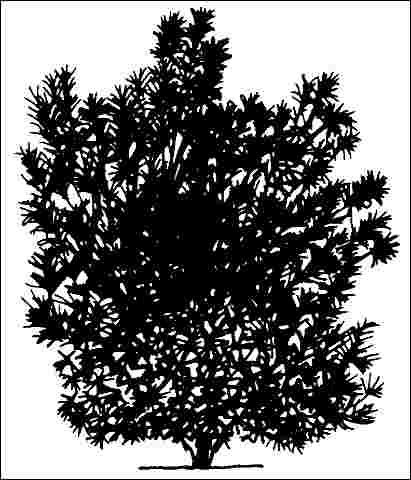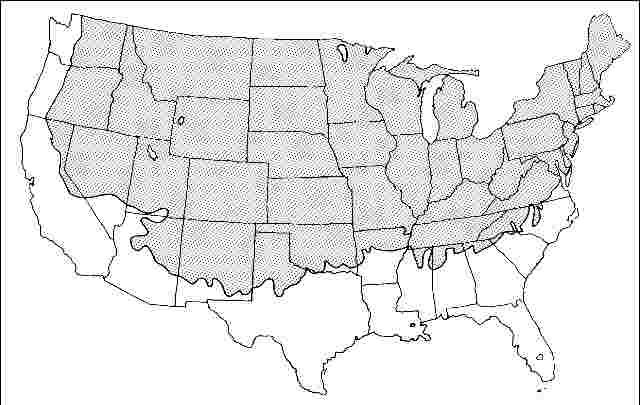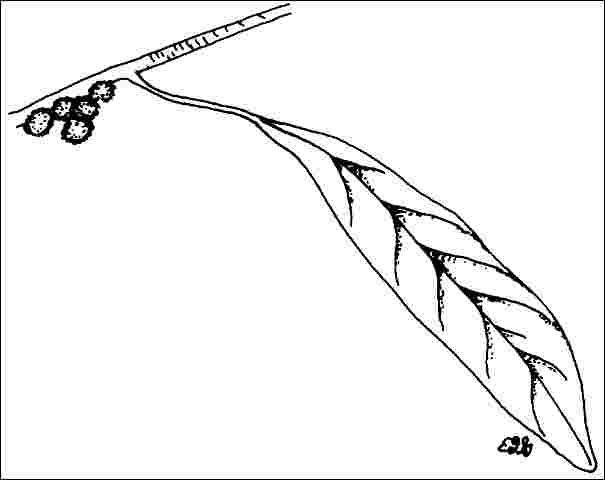Introduction
This shrub is hardy into USDA hardiness zone 2 and reaches a height and spread of six to eight feet. The glossy green foliage is followed by persistent, silvery gray berries on female plants that provide winter interest. Multiple, twisted trunks with smooth, light grey bark, aromatic, olive green leaves, and clusters of grey-blue, waxy berries on female plants which are attractive to wildlife are just some of the reasons bayberry is such a popular landscape plant. Most specimens form a multi-stemmed, open, rounded canopy of weak trunks and branches. This rapidly-growing, small, evergreen native tree is capable of reaching a height of 25 feet with an equal spread but is usually seen in the 10 to 20-foot range. Sometimes used as a large shrubbery screen, bayberry is ideal for use as a small tree, the lower limbs removed to reveal its picturesque form. One, or several clustered together, provide pleasing dappled shade for terraces or patios.

General Information
Scientific name: Myrica pensylvanica
Pronunciation: MEER-ih-kuh pen-sill-VAN-ih-kuh
Common name(s): Northern bayberry
Family: Myricaceae
USDA hardiness zones: 3A through 7A (Fig. 2)
Origin: native to North America
Invasive potential: weedy native
Uses: hedge; parking lot island < 100 sq ft; parking lot island 100-200 sq ft; parking lot island > 200 sq ft; screen; deck or patio; street without sidewalk; trained as a standard; container or planter; reclamation; highway median
Availability: not native to North America

Description
Height: 6 to 12 feet
Spread: 6 to 10 feet
Crown uniformity: irregular
Crown shape: round, vase
Crown density: open
Growth rate: slow
Texture: fine
Foliage
Leaf arrangement: alternate (Fig. 3)
Leaf type: simple
Leaf margin: entire, serrate
Leaf shape: oblanceolate, oblong, obovate
Leaf venation: pinnate
Leaf type and persistence: fragrant, deciduous, semi-evergreen
Leaf blade length: 2 to 4 inches
Leaf color: green
Fall color: no color change
Fall characteristic: not showy

Flower
Flower color: green
Flower characteristics: not showy
Fruit
Fruit shape: round
Fruit length: less than .5 inch
Fruit covering: fleshy
Fruit color: white/gray
Fruit characteristics: attracts squirrels/mammals; showy; fruit/leaves not a litter problem
Trunk and Branches
Trunk/bark/branches: branches droop; showy; typically multi-trunked; thorns
Pruning requirement: needed for strong structure
Breakage: susceptible to breakage
Current year twig color: gray, brown
Current year twig thickness: thin
Wood specific gravity: unknown
Culture
Light requirement: full sun, partial sun, or partial shade, shade tolerant
Soil tolerances: clay; sand; loam; acidic; extended flooding; well-drained
Drought tolerance: moderate
Aerosol salt tolerance: high
Other
Roots: not a problem
Winter interest: yes
Outstanding tree: no
Ozone sensitivity: unknown
Verticillium wilt susceptibility: unknown
Pest resistance: resistant to pests/diseases
Use and Management
Very tough and easily-grown, bayberry can tolerate a variety of landscape settings from full sun to partial shade, wet swamplands or high, dry and alkaline areas. Growth is thin in total shade. Bayberry is also very salt-tolerant (soil and aerosol), making it suitable for seaside applications. It is adapted to parking lot and street tree planting, especially beneath powerlines, but branches tend to droop toward the ground, possibly hindering flow of vehicular traffic if not properly pruned. Set them back from the road if used as a street tree so drooping branches will not hinder traffic. Heading the top back two times each year eliminates the tall, lanky branches and reduces the tendency for branches to droop. Some landscape managers hedge the crown into a multi-stemmed dome-shaped topiary.
Plants should be watered well until established and will then require no further care. The only drawback to the plant is its tendency to sprout from the roots. This can be a nuisance as they need to be removed several times each year to keep the tree looking sharp. However, in a naturalized garden this thick growth could be an advantage, since it would provide good nesting cover for wildlife. Only female trees produce fruit but seeds do not germinate in the landscape.
Pests and Diseases
There are no serious diseases or pests of this tree.